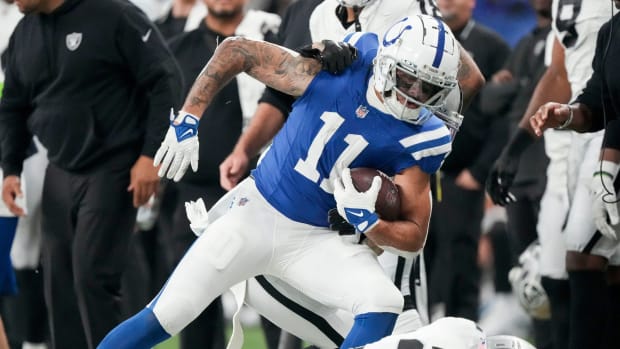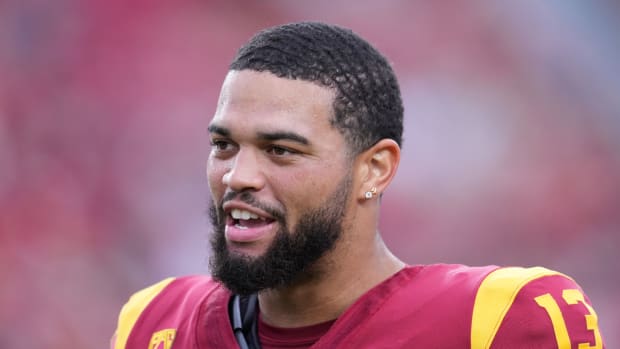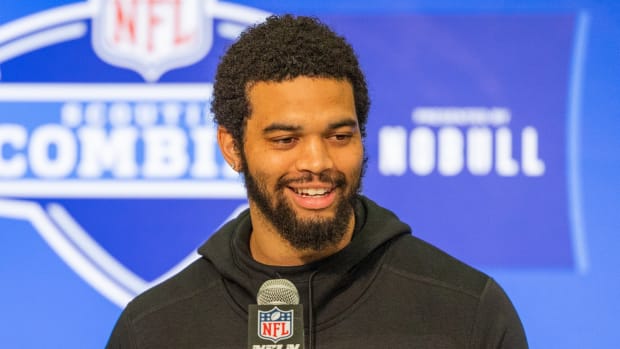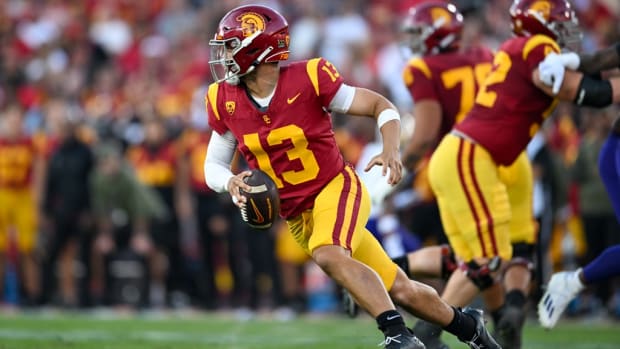USC's half-stepping vs. BYU a recurring recipe for defeat
PROVO, Utah -- USC losing to BYU isn’t stunning if you’ve seen this program at any point in the Clay Helton era. It might not even be surprising.
The Trojans have dropped seven of his nine September road games. The two wins came to teams that would finish with losing records. The seven losses were to ranked teams. BYU, of course, isn’t and likely won’t be. That’s probably why its fans rushed the field Saturday.
What BYU is, is tough, an honorary Power Five squad despite its independent status.
“BYU is a great team, physical, well-coached,” center Brett Neilon said.
Neilon wasn’t trying to indict his own team, but it’s been too long now since you could say those things about the Trojans. Probably since the Rose Bowl win over Penn State. That was three running backs coaches ago.
In a vacuum, there’s no shame in losing to BYU in the altitude at LaVell Edwards Stadium. The Cougars (2-1) would fit right in with the Pac-12, especially in the conference’s current state. And so does USC. And that’s the problem. The Trojans (2-1) don’t stand out.
After falling 30-27 in overtime, Helton and his players noted how BYU made one more play than them. It’s a slight to themselves, really, as if their talent advantage doesn’t supersede a single snap.
The Trojans didn’t lose because of a play. They lost because of themselves. More alarming is that their coach doesn’t seem to know it.
A myriad of questionable decisions speak to that, but look no further than those on the final possession for the most glaring. Down a field goal and starting at BYU’s 25, USC rushed for a 1-yard loss and had its hottest running back watching from the sideline. Another run by Vavae Malepeai made it third-and-6.
Wait, why did the Trojans run again?
“To get a third and manageable, which it did,” Helton explained. “You went from second-and-10 to third-and-5. … Instead of putting the kid (Kedon Slovis), all of a sudden you miss a pass (on second down) and you get another third-and-10 situation, he got it to a manageable distance. You try to get half on second down and then complete the third down and get the first.”
That leaves you only one chance and telegraphs a pass. It’s doubtful you pick up the conversion running, so you throw on both downs for a better shot of moving the sticks. Throw on second down and maybe you make it third-and short, which allows you to run or pass. Even if two passes fall incomplete, your kicker just proved he can boot it from 50-plus. Helton essentially admitted USC was prepared to settle for a field goal when a touchdown would win the game. The latter necessitated throwing.
And isn’t that what this Air Raid offense is ultimately designed to do?
BYU understood that early, and thus started to drop eight defenders regularly after USC easily marched down the field on its opening drive. The Trojans’ freshman QB was picked off twice in the first quarter of his first road start. Slovis was then held to 133 passing yards over the final three quarters after tallying 148 in the opening frame. It soon became evident Graham Harrell, who didn't address the media afterward, didn't quite know how to best attack the Cougars.
“They definitely went into a different front than they’ve been playing versus Tennessee and Utah,” left tackle Austin Jackson said. “Those in-game adjustments, we made them. Maybe we should have made them a little sooner.”
Helton added: “It was a ton of drop eight, trying to force the run game and I think we ended up with 170-plus yards. It was one of those where they were gong to force the issue there.”
BYU, which came into the contest allowing 252 rushing yards per game, was begging for the Trojans to run more. If only they’d helped USC out by asking for more Markese Stepp.
The sophomore bruiser didn’t play until the second quarter, turning three carries into 33 yards on a singe drive to set up a touchdown. He didn’t reappear until the first play of the fourth quarter. His next two carries converted first downs, when BYU knew USC was running, and his third went for seven yards.
Helton later pointed to him fumbling on that sixth carry as a reason he didn’t use Stepp more.
“He did a nice job, he put the ball on the ground one time and that’s where he’s got to learn in these types of games, it’s a violent game,” Helton said. “We were fortunate to get the ball back.”
Never mind that the fumble came with about seven minutes left in the fourth quarter. That USC recovered made it a moot point. That Stepp was muted for two entire quarters and overtime despite averaging 5.9 yards a pop and converting six first downs on just nine carries is indefensible.
Malepeai ran the ball 23 times and produced a modest 4.2 yards a carry, while Stephen Carr averaged 2.4 over nine attempts. Since the beginning of the Stanford game, Malepeai and Carr have combined to average 3.8 yards over 50 carries. Stepp is at 7.1 but with only 12 rushing attempts.
“I think I just took advantage of every opportunity I was given,” Stepp said. “Vae, Stephen, all the running backs prepared me for that, letting me know the assignments I had to take care of, what the reads (were). Hats off to them and hats off to the O-line for helping me take advantage of those opportunities.”
Stepp’s comment almost makes you wonder if he isn’t prepared for a larger role, though his production doesn’t suggest that. Whatever the case, count this as another game in which USC struggled to get the ball into the hands of its best players.
Helton said wide receiver Amon-Ra St. Brown had just one target because BYU’s Cover 3 was taking away the middle of the field.
“We actually tried to move him outside a couple times,” Helton said. “As you’ve seen in each game, and that’s what I like about the offense, there’s been a (different) leading receiver in each game. ... It’s hard in this offense to just focus on one guy. It's about what the defense gives us and being able to take what they give us.”
Hard to like anything that produces just one reception for four yards for arguably your best receiver. With Devon Williams no longer on the roster, St. Brown is also far and away the best deep threat. As good as the receiving corps is, the speed isn’t always there to stretch the field. Two of Slovis' three picks were passes over the middle in traffic intended for freshman Drake London.
Regarding the final one to seal the loss, Slovis said he saw grass and pulled the trigger. A deluge of defenders meant those openings closed fast.
“That was another frustrating thing, when they drop eight, there’s less space in the defense,” Slovis said. “I just need to hit the checkdowns more, and that gets frustrating as a quarterback when you want to push the ball downfield.”
USC’s defense was equally frustrated. Defensive coordinator Clancy Pendergast lamented his unit not always getting lined up properly, not preventing explosive plays, not sacking the quarterback, not setting the edge and not getting stops on third downs. It’s not anything new.
And perhaps neither is this team, really.
“This team is built for this,” Helton said. “To have adversity and then overcome it.”
And then have it again. Saturday was simply Groundhog Clay.




